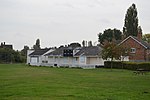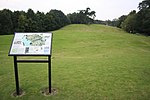Operation Epsilon
History of HuntingdonshireIntelligence of World War IIIntelligence operationsMilitary history of CambridgeshireNuclear program of Nazi Germany ... and 2 more
Operation EpsilonScience and technology in Cambridgeshire

Operation Epsilon was the codename of a program in which Allied forces near the end of World War II detained ten German scientists who were thought to have worked on Nazi Germany's nuclear program. The scientists were captured between May 1 and June 30, 1945, as part of the Allied Alsos Mission, mainly as part of its Operation Big sweep through southwestern Germany. They were interned at Farm Hall, a bugged house in Godmanchester, near Cambridge, England, from July 3, 1945, to January 3, 1946. The primary goal of the program was to determine how close Nazi Germany had been to constructing an atomic bomb by listening to their conversations.
Excerpt from the Wikipedia article Operation Epsilon (License: CC BY-SA 3.0, Authors, Images).Operation Epsilon
West Street, Huntingdonshire Godmanchester
Geographical coordinates (GPS) Address External links Nearby Places Show on map
Geographical coordinates (GPS)
| Latitude | Longitude |
|---|---|
| N 52.315833333333 ° | E -0.17916666666667 ° |
Address
Farm Hall
West Street 24
PE29 2HQ Huntingdonshire, Godmanchester
England, United Kingdom
Open on Google Maps










